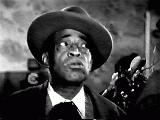Tim Moore To Play Kingfish On CBS Television Version of ‘Amos n’ Andy’ Show
 Tim Moore 62, of 718 Fifth Avenue, Rock Island, retired Broadway stage comedian whose light hearted humor has delighted the audiences of the world for the past 50 years, has been chosen to play the role of “Kingfish” in the television version of “Amos n’Andy”.
After blanketing the country in search of the right man for the role, Charles Correll (Andy), formerly of Rock Island, and Freeman Gosden (Amos), who plays both Amos and Kingfish in the radio show, remembered the famous colored star who returned to his old home town in 1946 to “spend more time with my people”.
The Columbia television network will feature the program, beginning this fall.
Tim Moore 62, of 718 Fifth Avenue, Rock Island, retired Broadway stage comedian whose light hearted humor has delighted the audiences of the world for the past 50 years, has been chosen to play the role of “Kingfish” in the television version of “Amos n’Andy”.
After blanketing the country in search of the right man for the role, Charles Correll (Andy), formerly of Rock Island, and Freeman Gosden (Amos), who plays both Amos and Kingfish in the radio show, remembered the famous colored star who returned to his old home town in 1946 to “spend more time with my people”.
The Columbia television network will feature the program, beginning this fall.
Moore was recommended for the role by E.F. Miller, of Miller and Liles of New York, producers of the Broadway hit “Shuffle Along”, which was the third show in stage history to do more than 500 performances on Broadway, and in which Moore had a role.
He was first contacted about a month ago and on July 8 he left for Hollywood by train. There he was given his screen and television tests at CBS, and a physical which he described as “as thorough as any soldier ever got.”
Gosden was in Hollywood and directed the tests. Tim returned from Hollywood on July 15. He made his first appearance on television in January of this year on Ed Sullivan’s “Toast of the Town” show in New Your, and on the stage of the Apollo theater there.
Sidewalk Career
Tim Moore began his stage career on the sidewalks of Rock Island, where he once shuffled and sang for the pennies and nickels people would toss to him. His favorite spot was the line of ticket buyers at Douglas park, where his troupe of street urchins would whistle “Turkey in the Straw” while Tim cut a neat buck-in-wing.
A passing vaudevillian spotted Tim and another featured performer of the Rock Island streets, Romeo Washburn, and made them a part of the act known as “Cora Mitchell and Her Gold Dust Twins”. After a long tour at a salary of $12 per week, Tim toured the British music halls for 18 months.
He then joined Dr. Mick’s Puritia company, a medicine show who played vacant lots all over the midwest. He returned home at the age of 15 and worked as a fly-shooer in a stable, a fight manager and a horse-racing jockey. By 1913 he had earned $110,000 as a prize-fighter, winning 84 of 104 fights.
Hits “The Big Time”
Tim returned to the stage and by 1925 was in the big time. He was with Lew Leslie’s Blackbirds for 15 months on Broadway and for two years in Paris. Rochester, of the Jack Benny program, also was in the cast. Mantan Moreland, now of the movies, got his starts under Tim’s tutelage.
The Rock Island man appeared in other Broadway successes, such as “Fast and Furious” “Take the Air”, in which he was the featured comic, and “Rhapsody in Black.” He also tried radio, being on a Westinghouse program for 18 weeks and on a Warden Lawes feature in 1934. From 1943 to 1946 he acted as the top comedian for a number of “name bands”.
In 1942, while he was the air-raid warden comic star of “Cavalcade,” the New York Times ran a 3-column feature article on Tim Moore. Tim has written practically all of his own comedy and many skits for others. One of his sketches, “Not a Fit Night for Man nor Beast,” was bought by the late W.C. Fields, who did a movie bit with it.
In his lifetime, Tim has earned as much as $1,500 a week and averaged about $500 a week for the last 20 years he was active. His $110,000 fight earnings he classifies as the first of three fortunes he has more or less “run through”.
Rock Island ‘Andy.”
Charles J. Correll, originally from Peoria, got his start in the entertainment field in Rock Island, where he had come to work as a bricklayer. He played the piano for the Metropolitan Minstrels in this city in 1915. He later joined the group as a baritone, took vocal lessons, and scored successes in the voice field. He took a job with the Jo Bren Productions company, a Chicago booking agency, and there met Freeman Gosden, the man who was destined to travel the high road of radio fame with him.
Motion picture fame also has marked the long history of the comedy team, which began radio work in New Orleans in 1922. From 1925 to 1929 they worked their way up as “Sam and Henry” until they were signed by the National Broadcasting company. They originated their first dialect show in 1925 and worked at $100 a week. By 1929, they were drawing annual salaries of $100,000.
Back

